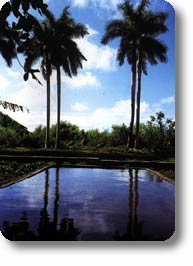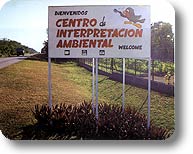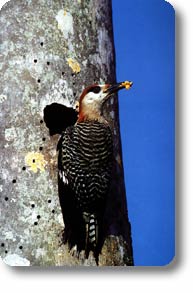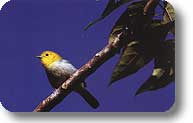|
Services
|
|
Scientific Research and Safeguard of Biodiversity
|



|
The scientific activity promoted by CITMA (Ministry of Science, Technology, and Environment) in the region of Zapata has given the opportunity to make several progresses in the field of ecology and safeguard of biodiversity and to elaborate various projects based on the direct participation by local population.
5 scientific stations have been built to ensure the conservation of natural resources and to promote scientific research.
Reproduction Center of the Cuban Amazon Parrot
The main goal of this center is the reproduction of the Cuban Amazon Parrot (Amazona leucocephala) in captivity, in order to safeguard wild populations, preserving them from the illegal capture of young specimens in nature, given the local and international interest for having this species in captivity. Another goal, not less important, is environmental education dedicated to young students. There is an ongoing scientific collaboration project between this center and the Faculties of Veterinary Medicine of Turin and Havana, financed by the Municipality of Turin.
Botanic Gardens
Besides giving the visitor the opportunity to discover the endemic flora thanks to a small garden, the function of the center is to take a census of the flora populating Ciénaga, and in particular of the potential medicinal plants.
At the moment, 140 species with medicinal value have been recorded: out of them, 38 are used for the production of phytomedicines, from which 35 therapeutic principles have been obtained. Some of them are already on the market.
Reproduction Center of the Indigenous Fish Fauna
The Center has achieved the reproduction in captivity of the "manjuarì" (Lepisosteus tristoechus), increasing every year the number of subjects used for the repopulation activities; moreover, thorough research has been carried out on its biology, revealing aspects which were still unknown. Research activities have had a considerable practical importance in the management of the center. The biology of the so-called "jicotea" (Trachemys decussata) is under study, in order to make its reproduction in captivity possible.
Crocodile Raising Center
There is ongoing research aimed at ensuring the conservation and development of the Cuban Crocodile (Crocodylus rhombifer). Its reproduction in captivity has been achieved, and every year the number of individuals for the repopulation activities grows. Here the several and important biological aspects for the management of the raising activity are analyzed, and biology and ethology of the wild population are under study. At the moment, in the center there are selected pure generations.
|
|
|




|
Center for Environmental Control and Management
The main task of this center is to develop and carry out projects and environmental research for the different institutions and production centers of the region. This kind of research aims at monitoring in time possible negative environmental impacts and at suggesting solutions avoiding the deterioration of the environment. Also research and environmental education activities that are mainly addressed to the inhabitants of Ciénaga are extremely important.
Moreover, many research activities are carried out in Zapata thanks to the support of international organizations like WWF, FAO and non-governmental organizations like Natura Hispanica.
Ecological Station "Fermin Cervera"
Within the cooperation projects between Parco dei Laghi di Avigliana and Ciénaga de Zapata National Park, Regione Piemonte has financed the creation of an ecological station in Santo Tomás. This structure will enable researchers to rely on a welcome point organized to lodge groups of scholars, providing them with all the necessary equipment. The center has been dedicated to the famous Spanish zoologist Fermin Cervera. A secondary function of the center, although not less important, is to create jobs for the inhabitants of Santo Tomás, in order to make them stay in the area.
|
Sport Fishing
|
If regulated according to conservation principles, sport fishing can be considered a compatible activity with the safeguard of biodiversity and can also work as a source of self-financing for the Park. According to the system adopted in Ciénaga, the management of the fish fauna should be entrusted to EMA which, through its biologists, fixes in the annual catch plans the quantity of fish that can be caught, the fishing methods, and the number of fishermen per day and per week - a few units - that can access each fishing area. Each fisherman is constantly followed by a guide having the double task to help and control him. The "No Kill" system is the most used: according to it, fish will be caught with fishing systems like fly-fishing and spinning, which will enable its survival and immediate release. Only specimens having a "record" size can be kept. Therefore, the catch is not significant with respect to the productivity of the environment.
There are only two sites where fishing is allowed: Laguna del Tesoro and Rio Hatiguanico.
Laguna del Tesoro is the largest freshwater basin in Cuba. The ideal place to stay overnight is Guamá, where it is even possible to fish from your own room, even if real fishing is carried out from the boat along the channels and mangrove swamps. The luxuriant vegetation characterizing the canebrake creates the ideal habitat for the reproduction and development of the Largemouth Bass (Micropterus salmoides), an alien species introduced in the area at the end of the 19th century from Florida. |
|
Diving Activity
|
|
With about twenty sites at sea and at least five cenotes, Bahia de Cochinos is in Cuba the ideal place for diving activities, both for snorkeling and for the more demanding diving activities with breathing apparatus.
Reaching the coral reef is very easy and it is not necessary to use a boat, since you can reach it directly form the beaches and cliffs, through metal ladders similar to the ones you find in the swimming-pools. Diving activities are also suitable for beginners, thanks to the presence of well-prepared instructors, both from a technical and naturalistic point of view. In the two hotels of Playa Larga and Playa Giron, short courses are organized: they can be defined as a "baptism" to diving activities and, after a couple of lessons in the swimming-pool, they give the opportunity to carry out some easy and safe diving activities, a first approach to the world lying underwater. |
|
Scientific Tourism
|

 |
CITMA Visitor Center is the ideal place where you can receive all the essential information to discover and visit Ciénaga, also thanks to the experience and availability of the staff. A small museum describes the various local ecosystems, from the forest to the marsh, to the seabed with one of the most beautiful coral reefs, as well as the geological events characterizing the history of Cuba. An important place is occupied by the history of the human settlements.
Near the center, crossing the road, there is a naturalistic route in the forest, called "Sendero del bosque sonoro" enabling the visitors of Ciénaga to experience a first approach with the local avifauna, also thanks to the presence of specialized guides leading the tourist to observe the various birds living in the forest, from the Cuban Trogon which is the symbol of Cuba, to the Cuban Tody and the Bee Hummingbirds (Mellisuga helenae), among the smallest hummingbirds of the world.
As we have already mentioned, in recent years the protection of endangered animal species in Ciénaga de Zapata has become a priority goal and therefore some recovery centers for endangered species have been built. Visiting these centers enables the tourist to consider the challenges and successes of the struggle for the safeguard of biodiversity.
The Crocodile Raising Center was the first to be established in 1960, with the aim to safeguard the Cuban Crocodile (Crocodylus rombifer), seriously threatened by poaching.
The Reproduction Center of the Cuban Amazon Parrot has the aim to produce in captivity the Cuban Amazon Parrot (Amazona leucocephala), object of excessive capture in the environment, as it can be easily domesticated.
The Reproduction Center of the Indigenous Fish Fauna has been established to safeguard the autochthonous fish species, and in particular the manatee (Atractosteus tristoechus), which, for the primitiveness of its anatomic structure and biology, is considered a living fossil. |

